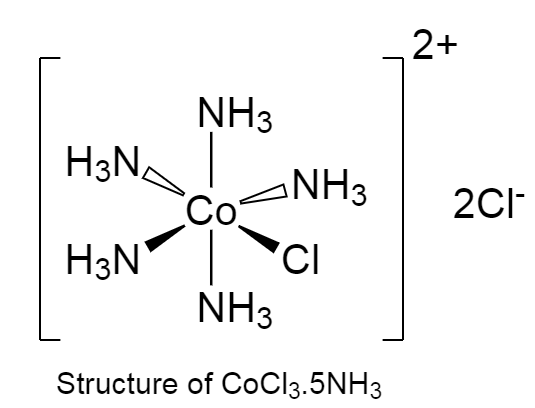
Number of ionisable and non ionisable $C{l^ - }$ ions in $CoC{l_3}.5N{H_3}$ respectively are, if one mole of it reacts with two mole of silver nitrate completely and forms ppt.
A.$3,0$
B.$2,1$
C.$1,2$
D.$0,3$
Answer
558k+ views
Hint: $CoC{l_3}.5N{H_3}$ is a coordination complex. This complex reacts with silver nitrate and precipitates. The number of ionizable and non ionizable ions depends on the type of valency in a complex.
Complete step by step answer:
-The IUPAC name of $CoC{l_3}.5N{H_3}$ is pentaamminechlorocobalt $\left( {III} \right)$ chloride.
-The structure of $CoC{l_3}.5N{H_3}$ is given below as follows:

-In the given coordination complex, five $N{H_3}$ molecule are directly attached to cobalt metal.
-Only one chloride ion is attached to cobalt metal.
-The rest of the chloride ion is satisfying the oxidation state of the metal.
-The chloride ion that is satisfying the oxidation of metal is called primary valency.
-And the one that is attached directly to metal is called secondary valency.
-Primary valency consists of ionisable ions whereas secondary valency consists of non ionizable ions.
-Primary valencies are satisfied by the negative charges whereas secondary valencies are satisfied by the positive charge or neutral species.
-The number of secondary valence shown by the metal is fixed.
-Thus, therefore the formula for the complex is $\left[ {Co{{\left( {N{H_3}} \right)}_5}Cl} \right]C{l_2}$ .
-One mole of $CoC{l_3}.5N{H_3}$ reacted with two moles of silver nitrate to form precipitate.
-Since the primary valency of chloride ions in the complex is two, therefore the number of ionisable ions will also be.
-Similarly for non ionizable ions, it is the same as secondary valency that is one.
-Thus, the number of ionizable ions is two and non ionisable ions is one.
So, the correct answer is option B) $2,1$ .
Note:Primary valency is the number of ions that satisfies the charge of the ion. Secondary valency is the same as the coordination number of a complex. In the structure of the complex, the primary valency is represented by a full line whereas the secondary valency is represented by a dotted line.
Complete step by step answer:
-The IUPAC name of $CoC{l_3}.5N{H_3}$ is pentaamminechlorocobalt $\left( {III} \right)$ chloride.
-The structure of $CoC{l_3}.5N{H_3}$ is given below as follows:

-In the given coordination complex, five $N{H_3}$ molecule are directly attached to cobalt metal.
-Only one chloride ion is attached to cobalt metal.
-The rest of the chloride ion is satisfying the oxidation state of the metal.
-The chloride ion that is satisfying the oxidation of metal is called primary valency.
-And the one that is attached directly to metal is called secondary valency.
-Primary valency consists of ionisable ions whereas secondary valency consists of non ionizable ions.
-Primary valencies are satisfied by the negative charges whereas secondary valencies are satisfied by the positive charge or neutral species.
-The number of secondary valence shown by the metal is fixed.
-Thus, therefore the formula for the complex is $\left[ {Co{{\left( {N{H_3}} \right)}_5}Cl} \right]C{l_2}$ .
-One mole of $CoC{l_3}.5N{H_3}$ reacted with two moles of silver nitrate to form precipitate.
-Since the primary valency of chloride ions in the complex is two, therefore the number of ionisable ions will also be.
-Similarly for non ionizable ions, it is the same as secondary valency that is one.
-Thus, the number of ionizable ions is two and non ionisable ions is one.
So, the correct answer is option B) $2,1$ .
Note:Primary valency is the number of ions that satisfies the charge of the ion. Secondary valency is the same as the coordination number of a complex. In the structure of the complex, the primary valency is represented by a full line whereas the secondary valency is represented by a dotted line.
Recently Updated Pages
A man running at a speed 5 ms is viewed in the side class 12 physics CBSE

State and explain Hardy Weinbergs Principle class 12 biology CBSE

Which of the following statements is wrong a Amnion class 12 biology CBSE

Two Planoconcave lenses 1 and 2 of glass of refractive class 12 physics CBSE

The compound 2 methyl 2 butene on reaction with NaIO4 class 12 chemistry CBSE

Bacterial cell wall is made up of A Cellulose B Hemicellulose class 12 biology CBSE

Trending doubts
What are the major means of transport Explain each class 12 social science CBSE

Which are the Top 10 Largest Countries of the World?

Draw a labelled sketch of the human eye class 12 physics CBSE

Explain sex determination in humans with line diag class 12 biology CBSE

The pH of the pancreatic juice is A 64 B 86 C 120 D class 12 biology CBSE

Give 10 examples of unisexual and bisexual flowers




